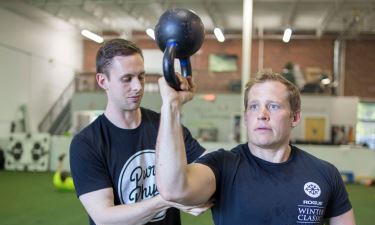Injuries will always occur and if research tells us anything, it’s that sports-related injuries have only continued to increase over the past decade.
However, emphasis on maintaining quality technique and form with lifting movements is a methodology that can and should be implemented by all coaches and athletes. Therefore, that’s why it’s the easiest way to reduce injury with Olympic weightlifting.
Power translates into faster, more explosive athletes. Evidence continues to mount showing that Olympic lifts are an effective way for athletes to rapidly improve power output. However, Olympic lifts are most effective when used to train the nervous system.
The goal is to build strength while simultaneously producing faster movement speeds.
Research tells us that Olympic lifts produce peak power at loads of 70-80%, and it makes sense as to why. The objective is not just to move weight, but to move weight in a fluid and powerful manner. When approaching 1RM loads, we often often sacrifice this aspect of “explosive lifting” in order to make the lift.
“Don’t just pile on weight, focus on technique” are words that my coaches have uttered repeatedly throughout training.
This concept is never more important than when working with novice lifters who are transitioning into Olympic weightlifting for the first time.
We’ve all seen the lifter who progresses too quickly with increasing his/her weight on the barbell. Inevitably, poor movement patterns and motor control are reinforced and now the lifter has limited his/her overall potential as an athlete.
Join the Pure Physio Newsletter!
This is why the best coaches often expose athletes to seemingly thousands of repetitions with broomsticks while learning the basic movements and methods of lifting.
While in some gyms it’s still not emphasized as much as it should be, technique still matters. In addition, we know that maintain proper technique becomes increasingly more difficult under heavier loads coupled with higher levels of fatigue.
The concept of maintaining quality technique and form is crucial when developing powerful and explosive athletes, but it’s also important to discuss when assessing risk for injury.
A recent study illustrated that injury risk was highest among strongman athletes when compared to powerlifting, CrossFit, and Olympic weightlifting counterparts.
What’s the reason for this?
In my opinion, it’s most likely due to the poor lifting technique and progressions seen and used in strongman training. Lifting a 410 lb stone to your shoulder doesn’t scream “back health.”
The injuries typical of elite weightlifters are primarily overuse injuries, not traumatic injuries compromising joint integrity.
Therefore, it may not seem important to optimize movement quality when you make it through the training day without an injury, but it’s important to prioritize longevity and long-term health over short-term accomplishments.
Maintaining quality movement and technique is something prioritized by USAW Olympic weightlifting coach, and co-owner of Pro Sports Performance, Reggie Hodges.
He notes that “If an athlete is under excessive fatigue, the potential to hold correct positioning is compromised. It’s wise to consider stopping an athlete from attempting max loads when correct positioning cannot be held. A quality lift at 90+% would be more desirable for me as a coach than a poorly done PR.”
Quality movement should not be taken for granted.
When movements are limited, stiff or sloppy, proprioceptive awareness cannot provide normal feedback.
Movement influences proprioception, and proprioception influences movement.
This, again, is where the minor details lie when correlating high-performance and risk for injury.
It’s not uncommon for coaches to focus on movements specific to the sport, but we should first prioritize the basic movements that all sports have in common. Rather than training a golfer with golf-swing specific flexibility exercises, for example, we should instead build sports skills on general athleticism and quality movement patterns.
To enjoy specific activities/hobbies/sports, we need to develop specific skills on top of basic function, not in its place.
If our goal is to improve the strength and power, but also the health and longevity, of our athletes, then quality movement must be of the utmost importance.
Thanks for reading,
Ryan


